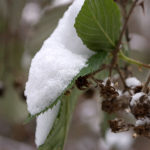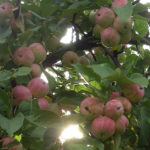Rose Novalis
The unusual lilac or blue color of the rose evokes ambiguous feelings. For some, she is a real aristocrat of "blue bloods", refined and elegant. For others, the color seems too cold, difficult to combine with the rest, brighter varieties. But the Novalis variety will not leave anyone indifferent. Our hero differs from other species with an unusual color in rather strong health and large flowers.
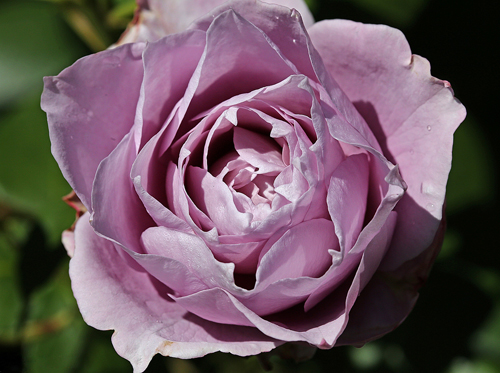
History of creation
Novalis belongs to German breeding and belongs to the floribund class. The variety was bred by the renowned rose growing company W. Kordes & Sons in 2010 and is part of the Fabulous Roses collection. The parent forms were unnamed rose seedlings, which were crossed in a controlled manner in the summer of 2004. The species was registered in 2011. The trade name in Europe is Novalis. In 2014, our hero is presented in the USA by Newflora as Poseidon. Original letter code KORfriedhar. The flower-aristocrat got its name in honor of the famous German philosopher, poet and writer Friedrich von Hardenberg (1772 - 1801), who was published under the pseudonym Novalis. In his novel Heinrich von Ofterdingen, the blue flower is presented as a symbol of the unattainable ideal of the German romantics: “No, it was not the treasures that awakened my indescribable attraction. Self-interest is far from me: I yearn for a blue flower, I would only see a blue flower. "
The American name of our hero Poseidon is similar to another novelty, but from French breeders. In 2015, Pierre Orard created the vibrant multicolor Poseidon, whose middle name is Tropical Lightning. The French novelty is a semi-pebbled variety, which is considered a climber.
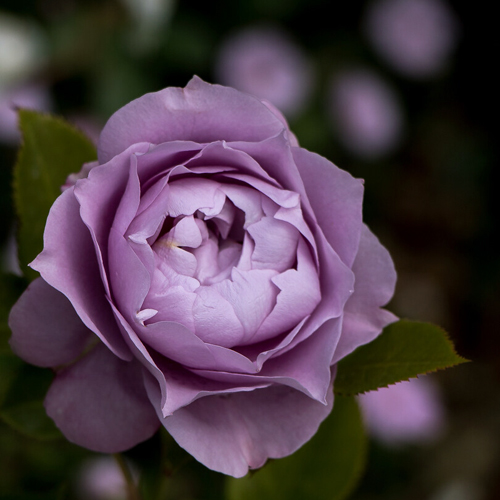
Awards
Despite his very young age, Novalis was awarded the highest ADR Anerkannte Deutsche Rose Novelty Trial award in 2013.
Description
The plant is erect, branched. Shoots are vertical, thick, very strong. The bush is moderately fluffy, neat and compact. Height 80 cm, width 40 cm. But without proper pruning, the shrub can grow under 2 meters. Sufficient leafiness. Leaves are healthy, large, rich green, pinnate, with a slightly shiny surface. As a rule, one shoot bears from 1 to 3 flowers, but inflorescences can consist of more buds. A strong leg holds even a multi-flowered inflorescence well, although there is information that the shoot can droop, not withstanding the load, then the bush becomes a little sprawling.
The buds are rounded-ovate, with a pointed apex. Opening, they turn into lush, densely double flowers, consisting of more than 41 petals (according to some sources, the bud has 70 - 75 petals) of a very interesting shape with a pointed top. At the beginning of the dissolution, the shape of the flower is cupped, then it becomes like a rosette. The size is large - about 10 cm. The color can be described as light lilac or light lavender, very delicate. In the diffused shadow, the tones will be deeper and colder, in the sun a pink tint appears. Towards the end of flowering, the color becomes ash-lilac or gray-steel with a pearlescent overflow.
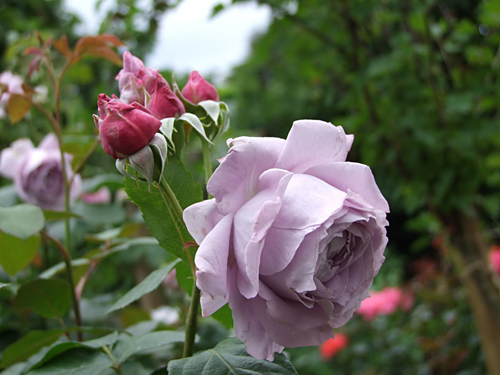
Bloom
Novalis is a multi-flowering variety. With sufficient care and in the right place, the plant can bloom in tides throughout the season. The ornamental shrub blooms profusely, due to the high bud-forming ability, there is no obvious break between flower tides. The flowering period for floribunda is long - it begins in late spring and lasts until the onset of cold weather. Faded rosettes must be removed in a timely manner in order to maintain the decorative effect of the shrub at a high level. By the way, rose growers note that at all stages of flowering, the color of our hero remains very unusual and attractive. The aroma is soft, fruity, subtle.
Characteristics
- A year after planting, the Novalis bush can show good growth rates and first flowering;
- beautiful floribunda demonstrates good winter hardiness, it is able to withstand frosts down to minus 23 ° C. For example, there is information that in the Central region, namely in the Kaluga region, the rose hibernates without problems;
- the plant does not tolerate heat well. In the south, in direct sunlight, the flower quickly loses its attractiveness, bakes;
- immunity is very good, which is confirmed by many rose growers. Our hero has a high resistance to black spot and powdery mildew;
- there is also evidence that the plant tolerates short dry periods well;
- has an average resistance to rain, the description says that some flowers may be damaged. The opinion of flower growers about moisture resistance was divided. Some were satisfied with the rose's behavior in the rainy season and argued that the culture tolerates high humidity well. Others noted that the buds did not have time to open, the thin petals of the already blooming rosettes began to rot.
Planting and leaving
Florists recommend choosing the spring period for planting Novalis - from mid-April to the end of May. True, in the southern regions, the best time for this process is warm and humid autumn. In order for the culture to be able to show its decorative effect, the right place should be chosen. Usually these are sunny areas, but in the south, diffused partial shade is recommended. If the place is still not suitable, then a healthy plant will tolerate transplanting quite easily. The care is usual for the culture. Watering is moderate, up to 1 time per week, but natural precipitation must also be taken into account. In the heat, the bush is moistened 2 times a week. The soil in the trunk circle should be kept clean, so weeding should be done regularly. Top dressing is performed both with organic matter and with mineral fertilizers. By winter, the root area is mulched, and the bush is covered with any material that allows air to pass through. Pruning promotes abundant flowering. In the spring, shoots thickening the bush, old, weak or dead branches are cut off.
Rose Novalis is a very recognizable variety, which from year to year is becoming more and more popular in its color segment. But for these fabulous flowers, it is quite difficult to find a suitable companion, perhaps varieties with a calm, noble color will make a good pair. Our hero looks great in a monochrome planting, but to achieve a decorative effect, you need to plant at least 3 bushes. The culture is suitable for creating a hedge, it can also be grown on a trunk. The plant is unpretentious in care, shows good resistance to the main diseases of roses and frost resistance. If you choose the right site for planting, our hero will charm you with fabulous beauty, abundant flowering, which will complement a delicate pleasant aroma.
